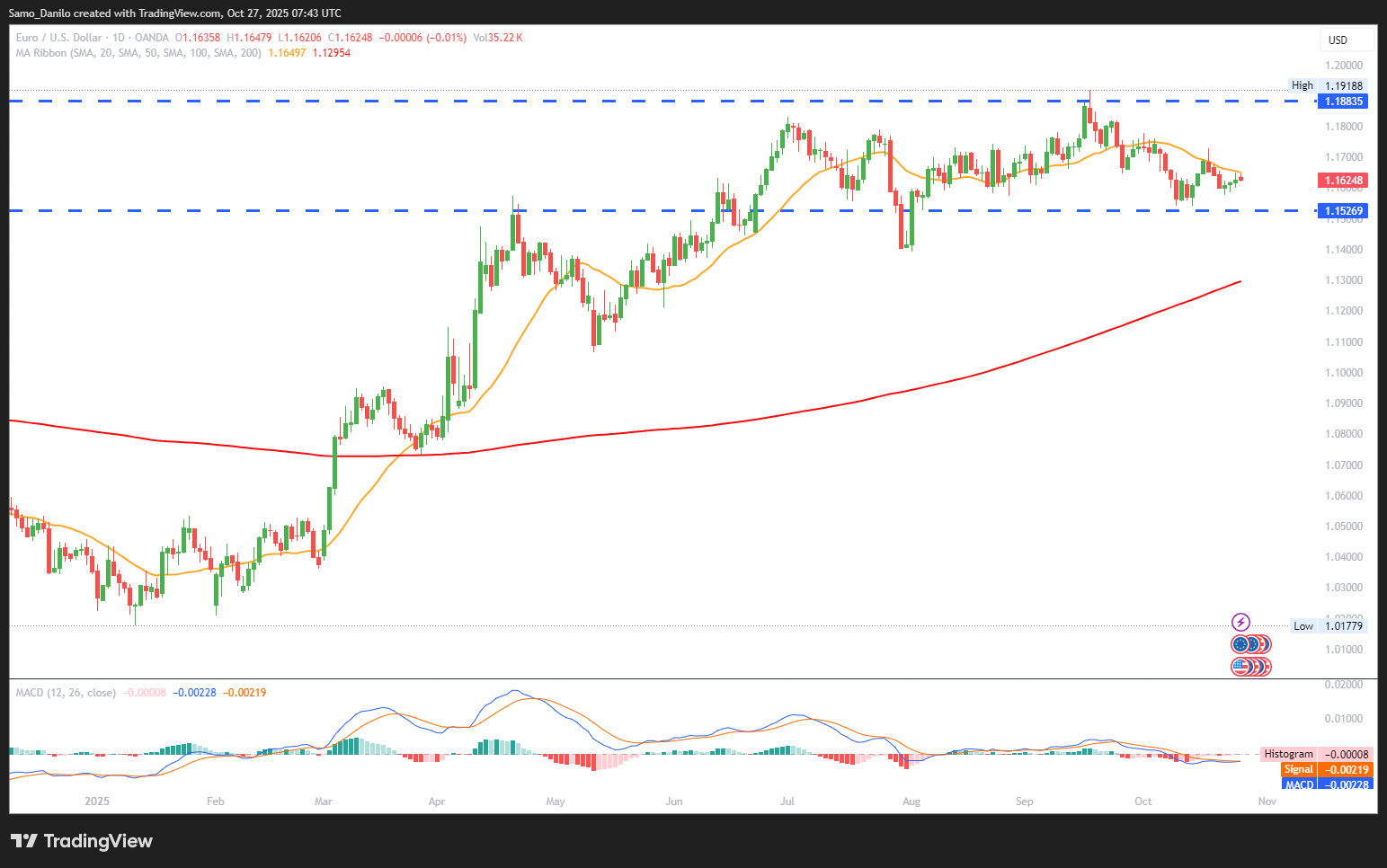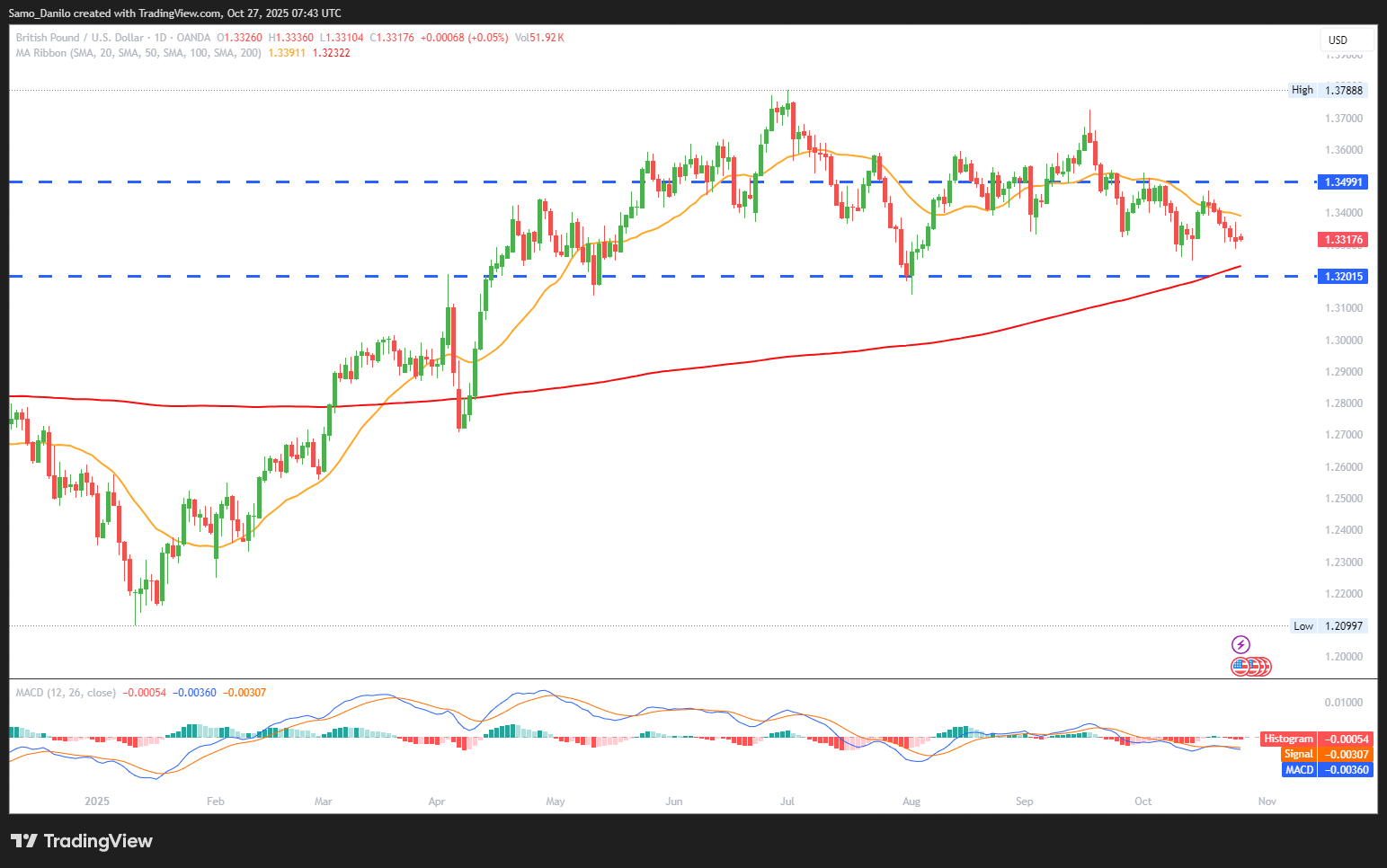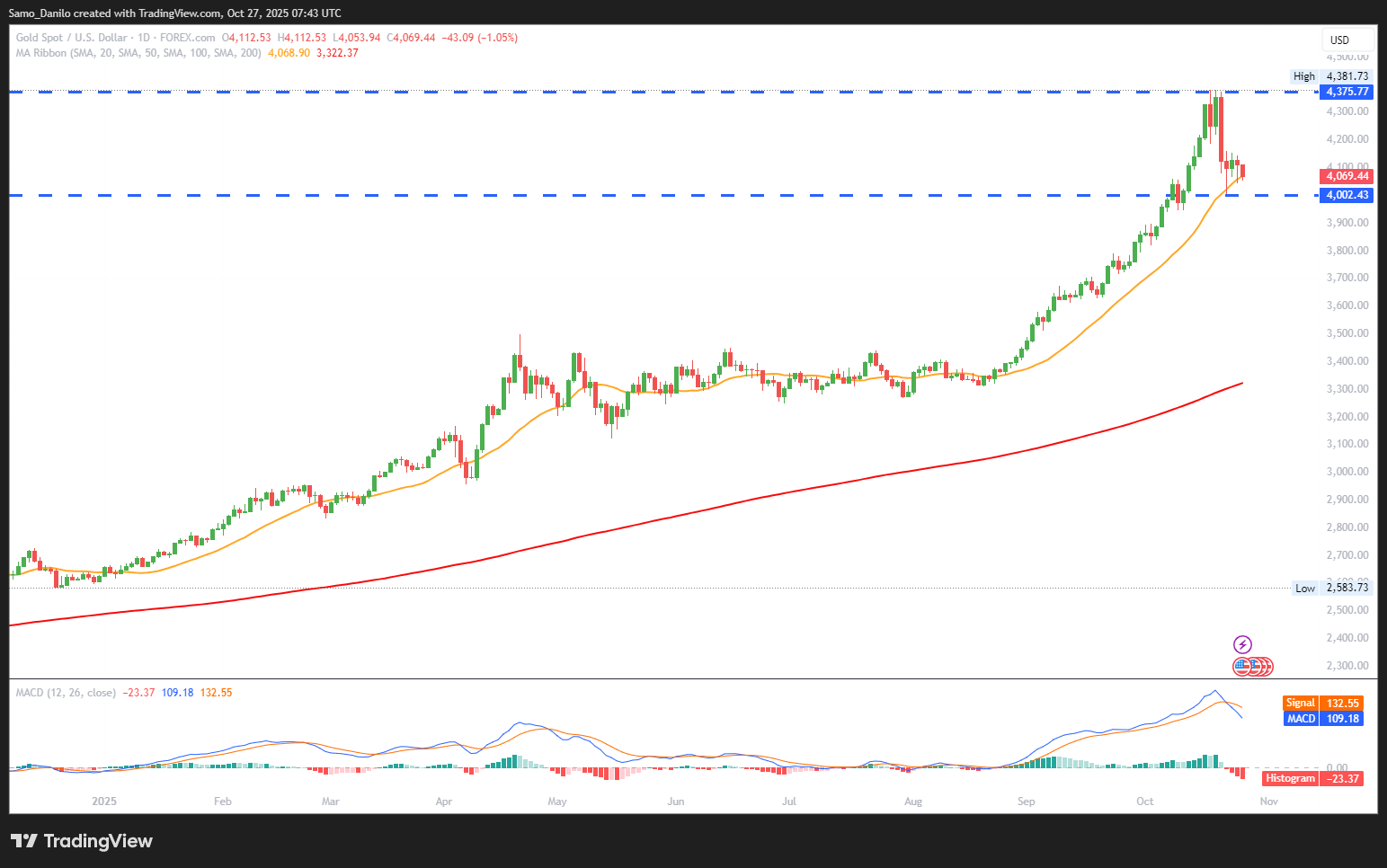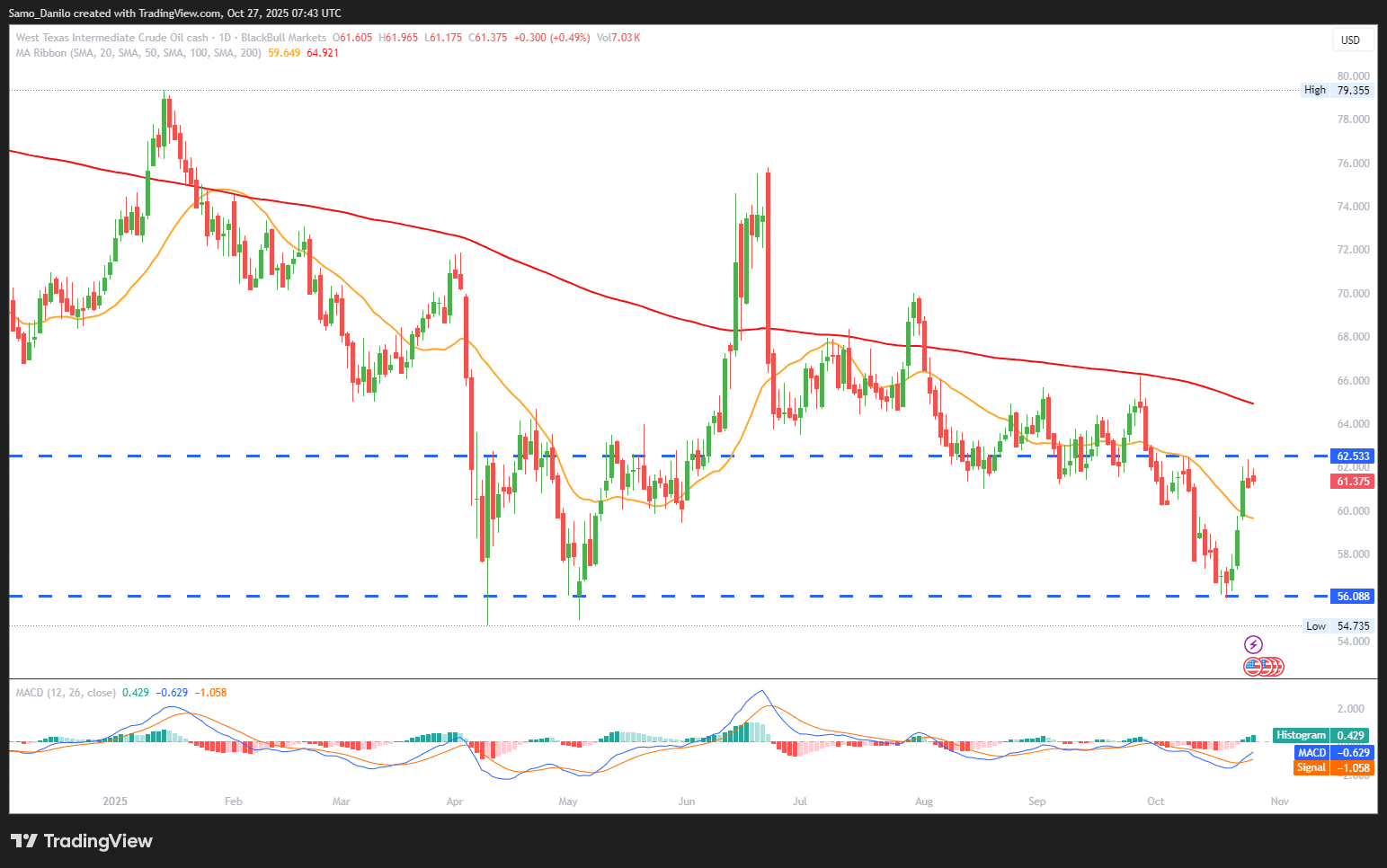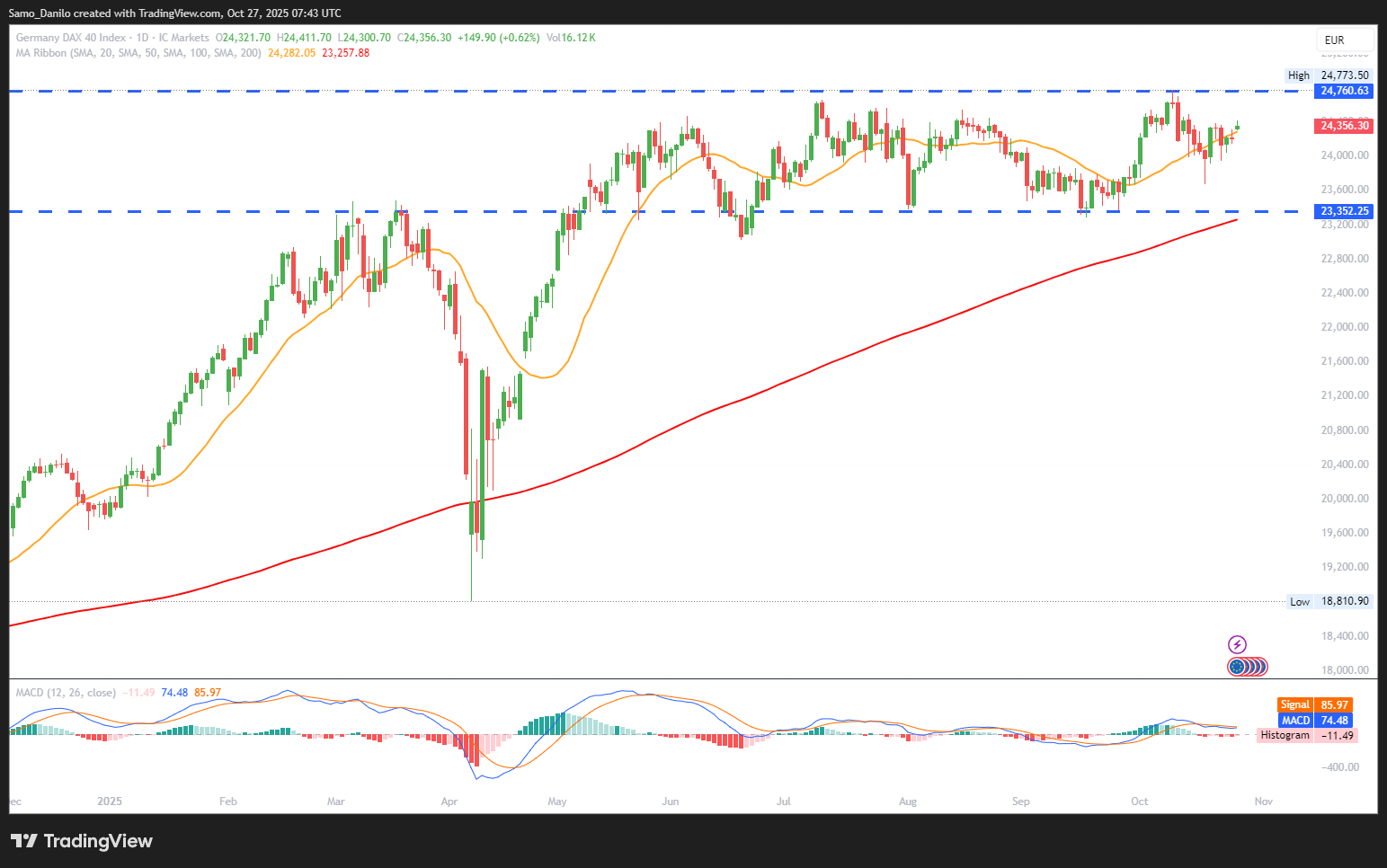EURUSD
- EUR/USD Price: The pair remains under pressure near the 1.1600 level in early European trading as a resilient U.S. Dollar extends its recovery, driven by position adjustments and renewed demand for safe-haven assets.
- Consumer Confidence: The latest data showed October Consumer Confidence rising to -14.2 from -14.9, indicating modest sentiment improvement among European households, though still well below pre-crisis levels.
- ECB Comments: Diverging signals from ECB policymakers keep investors cautious: Kazaks suggested that the next rate move could go either way, while Villeroy argued a cut is more likely, and Kocher maintained an even balance between the two.
- French Politics: France’s Socialist Party leader Olivier Faure threatened to bring down Prime Minister Lecornu’s government if budget reforms fail to impose higher taxes on billionaires, raising political instability risks in the Eurozone’s second-largest economy.
- Macron Comments: French President Emmanuel Macron is urging the EU to activate its Anti-Coercion Instrument in response to China’s economic measures, signaling a potential escalation in EU–China trade tensions.
Closing statement: The EUR/USD remains pressured near 1.1600, weighed by U.S. Dollar strength and Eurozone political divisions. While slightly better confidence data provides limited relief, policy uncertainty and French domestic risks continue to undermine investor appetite for the Euro in the near term.
GBPUSD
- GBP/USD Price: The pair begins Monday’s European session slightly weaker but holding above the 1.3300 level, as traders show limited conviction ahead of key global events and central bank decisions.
- BoE Expectations: Growing expectations of further Bank of England rate cuts, combined with concerns over the UK’s fiscal trajectory ahead of November’s Autumn Budget, continue to dampen investor sentiment toward the Pound.
- US Meetings: The White House confirmed President Trump’s upcoming meetings with Japan’s Prime Minister Takaichi on Tuesday, South Korea’s President on Wednesday, and China’s President Xi Jinping on Thursday in Seoul — events likely to influence global trade dynamics and risk sentiment.
- UK Retail Sales: Retail activity in the UK rose 0.5% in September, defying forecasts for a 0.2% contraction, marking the strongest retail performance in over three years and offering a temporary cushion for the Pound.
- FOMC Policy: With the Federal Reserve’s two-day meeting starting Tuesday, investors are avoiding aggressive positions in GBP/USD until clarity emerges on the Fed’s rate path, expected to shape near-term Dollar momentum.
Closing statement: The GBP/USD pair remains fragile above 1.3300, balancing between BoE dovish expectations and surprisingly resilient UK retail data. Broader direction hinges on FOMC policy signals and developments from Trump’s Asian tour, both likely to steer short-term volatility.
XAUUSD
- XAU/USD Price: XAU/USD remains under mild pressure at the start of the European session on Monday, trading within a narrow multi-day range as conflicting fundamental drivers keep traders cautious and volumes light.
- US Inflation Data: The latest CPI report showed a 0.3% monthly rise in September, leaving the annual rate at 3%. Core CPI rose 0.2% month-on-month, matching expectations — results that failed to shift Fed rate-cut bets meaningfully.
- Government Shutdown: The White House signaled that October’s CPI data may not be released due to the ongoing government shutdown, now in its 27th day, nearing the record length seen in 2018. The prolonged deadlock adds uncertainty to economic assessments and pressures investor sentiment.
- Fed Expectations: Markets are pricing in a rate cut to 3.75–4% at the upcoming FOMC meeting, with another 25bps reduction likely in December. Such expectations limit downside for gold, as lower rates diminish the opportunity cost of holding non-yielding assets.
- US-China Trade: Treasury Secretary Scott Bessent confirmed progress in Kuala Lumpur talks during the ASEAN Summit, noting the removal of potential 100% tariffs on Chinese imports that were set to begin November 1 — a development that reduces safe-haven demand for gold in the near term.
Closing statement: Gold remains trapped between easing Fed expectations and shifting risk sentiment, with rate cut bets supporting the downside, while reduced geopolitical tension and the shutdown’s economic uncertainty limit bullish momentum. XAU/USD may continue consolidating until a clear catalyst breaks the current range.
CRUDE OIL
- Crude Oil Price: West Texas Intermediate (WTI) crude slips to $61.10 per barrel, slightly below Friday’s close at $61.29, as bearish momentum persists amid soft demand outlooks and renewed geopolitical tension.
- Drone Attack: Ukraine’s latest drone strike on Russia’s Ryazan refinery, one of Rosneft’s largest facilities, halted a major distillation unit after part of the plant caught fire. The outage raises short-term supply concerns, though the market reaction remains muted due to ample global inventories.
- Russia Response: Over the weekend, Russia launched extensive drone and missile attacks across Ukraine, including Kyiv. President Vladimir Putin announced a successful test of a nuclear-powered cruise missile, intensifying geopolitical risks, yet traders appear more focused on demand-side weakness for now.
- US Oil Majors: Lower 2025 oil prices compared to last year have pushed US producers such as ConocoPhillips, Chevron, and ExxonMobil to cut jobs and streamline operations. These moves underscore industry-wide cost discipline in response to softer profit margins.
- Sanctions Disruptions: Russia-owned NIS halted crude processing as US sanctions blocked deliveries via Croatia’s JANAF pipeline, leaving one million barrels of Kazakh crude stranded at the Omisalj terminal. The incident heightens regional energy security concerns ahead of the winter season.
Closing statement: WTI crude faces a tug-of-war between geopolitical supply risks and subdued demand sentiment. While refinery outages and sanctions hint at short-term volatility, weak economic activity and ongoing cost-cutting in the oil sector suggest that upside potential remains limited in the near term.
DAX
- DAX Price: The German DAX index trades around 24,355 points, maintaining levels close to its record high as investors weigh geopolitical uncertainty, corporate earnings, and central bank policy ahead of a data-heavy week.
- Eurozone PMI: October PMIs across the euro area exceeded forecasts, with the composite index at 52.2, marking the strongest reading since May 2023. The services sector led the rebound, while manufacturing returned to the neutral 50.0 mark, hinting at gradual stabilization in regional activity.
- ECB Policy: ECB Governing Council member José Luis Escrivá commented that current borrowing cost levels are appropriate, reinforcing expectations that the central bank will keep rates steady for the foreseeable future as inflation continues to moderate.
- Business Sentiment: Markets are awaiting the IFO Business Climate Index release, expected to inch higher to 87.8 in October. A stronger-than-expected reading could bolster confidence in Germany’s economic recovery, though overall sentiment remains fragile amid external headwinds.
- Corporate Earnings: The week will feature quarterly reports from major German companies, including Adidas, Airbus, Mercedes-Benz, BASF, Volkswagen, and Deutsche Bank. These results are likely to set the tone for short-term DAX direction and investor sentiment toward the German equity market.
Closing statement: The DAX remains buoyed by solid eurozone data and steady ECB policy, but corporate earnings and business sentiment figures will be key in determining whether the index can extend its record run or faces a short-term consolidation phase.
